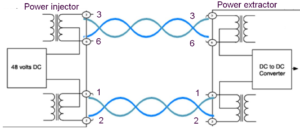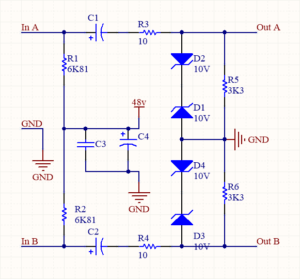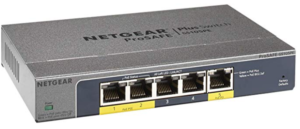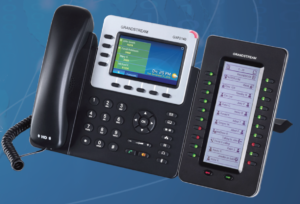
This blog article talks about “power over ethernet” or POE. Those who are affected by work-from-home arrangements might find it helpful to learn a little bit about POE even if you have not been trained in electrical engineering. This article talks a little bit about POE.
There are a couple of sound-bite things about power over ethernet to memorize and to keep in mind. These sound bites will stand you in good stead at cocktail parties, and will get you invited back, or at least they would except that you will likely not be attending any cocktail parties in the next few weeks, sorry about that. But anyway, life will eventually be back to normal, I promise, and one of the signals to you that life will have gotten back to normal will be that some day you are once again able to attend a cocktail party.
The main point here being that you can let slip, just loudly enough to be overheard by those nearby, that you had gotten power over ethernet working for your VOIP phone. And heads will swivel and people will cluster around to ask how you got it to work. And here is my promise to you — you will get invited back to future cocktail parties hosted by that host.
POE lets you power your VOIP phone from the office using just one cable. Yes, what we are accustomed to is that everything in our lives these days that runs on electricity requires two connections to work — a power connection on the one hand, and an Internet connection on the other hand. Most office-type VOIP phones are unable to connect to the Internet by means of wifi. They connect to the Internet only by means of ethernet. What’s really neat about POE is that if you can get POE to work, you can deliver both power and Internet connectivity to your VOIP phone by means of a single cable.
This is super handy because then you can use a twenty-foot or thirty-foot ethernet cable with that VOIP phone. And you can easily move the phone around to whatever location in the room is convenient. There’s no need to wrangle a new power hookup when you move the phone around.

POE is a lot like phantom power. The alert reader who has worked with condenser microphones that have XLR cable connections will instantly recognize that POE is a lot like the “phantom power” approach to providing a DC power supply to a microphone. So at the cocktail party you might let slip, just loudly enough to be overheard, that “POE is a lot like phantom power”. This gives you two chances of having somebody’s head swivel around to see who is talking — it might be a fellow cocktail party guest who knows about POE, or a fellow cocktail party guest whose misspent youth, like yours and mine, included a lot of time stringing XLR cables to condenser microphones that required phantom power.
Practical steps for your home office. So one action step for your home office is maybe that you will swap out your old ethernet switch for a newer one that provides power over ethernet on its LAN ports. And while you are doing this, pick an ethernet switch that is at least 100 megabits per second and maybe gigabit in its bits-per-second data rate.

Another thing is that you will almost always find that you have only one ethernet jack at your desk location and you need to plug in at least two things at your desk location — the VOIP phone and your work computer and probably at least a third device such as a media streaming stick (e.g. a Fire TV stick).
If your main ethernet switch is that kind that provides POE then you can use a product such as this Netgear GS105PE switch at your desk location. This product does not need an electrical outlet for its electrical power. The right-hand port on this switch is the “upstream” port and you plug it into the ethernet jack that goes back to your main ethernet switch. Your main ethernet switch provides power over ethernet and it powers this Netgear GS105PE switch. This Netgear GS105PE switch in turn provides power over ethernet on either of the leftmost two ports, to your VOIP phone for example. And you can plug in your WFH computer into the third or fourth ports that do not provide POE.
How POE works. For the reader who is electronically inclined I will offer a few words about how POE works (which is also a discussion of how phantom power works). The general idea is that you already have some physical communications channel that until now was used only for a very low-power and fairly high impedance balanced-line communications path. In the case of a microphone connection, it is an XLR cable which has a shielded twisted pair providing an audio signal path, and elsewhere within the cross section of the cable there is a ground-and-shield path. The twisted pair got chosen sixty years ago by the designer of the XLR standard because a twisted pair is pretty darn good at rejecting “common mode” interference. Any unwanted outside signal that would risk introducing noise in the line is going to very likely get picked up almost identically in each of the two conductors of the twisted pair. At the end of the cable that is receiving the audio signal (the end where the mixing board and amplifier and speakers are located) the two wires reach a two-input circuit that rejects any common-mode signal received on the two wires. Only the differential signal on the two wires gets paid attention to. That differential signal is likely to be a fairly faithful transmission of the vibrations in the air that the microphone picked up from the performer’s voice.
What happened next after this XLR standard got set is that microphone makers started coming up with microphones that needed to receive some DC power to power up a condenser microphone preamplifier circuit within the microphone. Yes you could just put a battery into the microphone, but a battery tends to be rather uncooperative because it will invariably run out in the middle of a concert. So the microphone makers decided to try to make the old XLR standard that was optimized solely to pass analog audio signals perform double duty, into an XLR standard that would also pass a DC power current to the microphone.

Of course you want the passing of the DC power current to be “orthogonal” to the passing of the analog audio signal current. You want each one of these two currents to have as close as possible to absolutely no interaction with the other one of these two currents.
The trick is to supply “phantom power”. You use two resistors R1 and R2 in the schematic that are identical in value. You inject 48 volts DC into the middle of that resistor bridge. The DC passes out from your mixing board in a balanced way on the two conductors (the twisted-pair shielded conductors) in the XLR cable. The DC return path is through the shield (ground) conductor of the XLR cable. If all goes well, the fact that you are running DC power delivery activity on the same three conductors that are also running an AC analog audio signal delivery activity will not be a problem. The two activities will hopefully not interfere with each other.

That’s how the phantom power works for the microphones. How does the power over ethernet work? Pretty much the same. Ethernet can be passed over as few as two twisted pairs, as shown in the image at right. Your ethernet switch transmits its ethernet data signal on pins 3 and 6 and your computer or other remote device picks up the signal on those pins. The computer or other remote device transmits on pins 1 and 2 and your ethernet switch receives the signal on those pins.
The idea of the twisted pairs is the same as in the XLR cable. The two conductors of a twisted pair, subjected to potential interference and noise along their length, will likely pick up the noise very nearly equally on the two conductors. The noise is thus “common mode” and can be easily rejected by using a balanced input device at the receiving end. A transformer is a handy way to accomplish this.
The designers of the ethernet cable do a clever thing. The twisted pair for pins 3 and 6 might be twisted with, say, a twist every four centimeters. Along the same cable, the twisted pair for pins 1 and 2 would be twisted with a twist say, every five centimeters. This means that to the extent that one pair acts as an antenna transmitting potentially interfering electrical energy toward the other pair, there is not any repetitive coupling between the two pairs. If they both had a twist every four centimeters the would couple to each other fairly well. But with non-identical twist periods along their length, there is not much coupling between the two pairs. This reduces so-called “crosstalk” between the pairs.
The alert reader will immediately draw a comparison with the prime-number annual gestation periods of cicadas (Wikipedia article). The cicada arranges to gestate only every thirteen or every seventeen years. If all goes well, the natural predators of the cicada will gestate with some other periodicity that is not 13 or 17. The peaks and valleys will almost never line up between the population maxima for the cicadas and their predators. And so most of the cicadas will not get eaten when they gestate.
A so-called “category 5” ethernet cable is thus almost exactly like a cicada. The peaks and valleys of the 1-2 twisted pair almost never line up with the peaks and valleys of the 3-6 twisted pair.
Which then brings me to the third sound bite that you can let slip at the cocktail party just loudly enough for others to hear:
The twisting patterns in a Category 5 ethernet cable are really very analogous to the gestation cycle in a thirteen-year or seventeen-year cicada.
Imagine the chances of getting heads to swivel with this sound bite. The ears of the entomologists at the cocktail party will perk up. And the ears of the local area network tech support people at the cocktail party will perk up. Yes, yet another sound bite that will get you invited back to cocktail parties. And yes I promise you some day you will again have the opportunity attend a cocktail party. I promise this.
But I digress. So our starting point from sixty years ago is that the ethernet standard for ten megabits per second ethernet was optimized solely for faithfully passing a fairly delicate analog signal along each twisted pair, to send ones and zeroes along each pair from one end to the other. Then maybe forty years ago, it was decided to try to cram a completely different function onto the same physical conductors, namely passing a sledge-hammer blow of high-current DC power over the same conductors.
Just as with XLR cables, the goal in these ethernet cables is that the DC power delivery activity will be “orthogonal” to the analog data delivery activity. The goal is that neither will interfere with the other. Looking at the schematic, we see that at the power injection end of the cable, we use center-tapped audio transformers. We inject 48 volts DC into the center tap for one twisted pair, and we connect DC ground at the center-tap for the other twisted pair. At the power extraction end we reverse the process using two more center-tapped audio transformers.
One fun thing about this is that you can play this game of POE even if the devices at the two ends of the able do not understand anything about POE. You can interpose an “ethernet power injector” at the switch end, and an “ethernet power extractor” at the computer-or-other-device end. The injector and extractor can be standalone little boxes that are connected by means of one-foot-long ethernet cables to the devices at each end.
But of course in 2020 what you find is that nearly all VOIP desk telephones are able to extract the POE power from such an ethernet cable. The telephone can thus function without the need for any local AC power adapter. The telephone gets both its Internet connection and its power supply on a single ethernet cable.
Many other devices, for example wifi access points and security cameras, are likewise designed nowadays so that they too can get their power from the ethernet cable.
The remaining thing that I have glossed over is that the POE standard includes a bit of handshaking between the devices at the two ends of the cable. The device that hopes to be powered by POE is obligated to draw at least a certain amount of current and this signals to the device that is supplying the power (at the other end of the cable) that it should in fact supply DC power on that ethernet port. Otherwise the ethernet switch will make a decision not to supply POE power on that port.
Why 48 volts DC? Why did the designers of phantom power, and the designers of POE, pick 40 volts and not 37 volts DC or 55 volts DC or some other number of volts?
The answer has to do with the state electrical codes and the national electrical code. Seventy or so years ago the drafters of these codes arrived at a bifurcation in the regulatory environment. The drafters of these codes wanted to regulate the heck out of what you can and cannot do if you are running ordinary 120-volt AC power. The manufacturers of stuff that connects to 120 volts AC had to be regulated from here to there and back again about insulation and drop tests and no openings big enough that a child could stick in a paper clip and somehow touch one of those Super Dangerous Wires that has 120 volts on it. The electricians running wires through walls had to protect that Super Dangerous High Voltage from damage, maybe by metal conduit or other physically strong things. And the electrician running those Super Dangerous Wires had to be Licensed Electricians. And before you could hook up the Super Dangerous Electricity to the Super Dangerous Wires you had to get a signoff from a building inspector.
In that world of seventy years ago, there was a subculture of makers of stuff and runners of wire who did not at all want to be regulated so closely. Who was it? It was The Telephone Company. Yes back then there was exactly one Telephone Company. The Telephone Company wanted to be able to run any old kind of cable through the walls and connect up any old phone jacks and stuff. And The Telephone Company did whatever was necessary to convince the drafters of the state electrical codes and the national electrical code that so long as you don’t have more than 48 volts running through your wires, it is Not Dangerous At All. How did the lobbyists from The Telephone Company arrive at the number 48? Because that is how many volts are in phone wires. A phone that is on the hook has 48 volts available to it from the telephone company central office.
And how did the Telephone Company pick 48 as the number of volts? Because car batteries are 12 volts and you can stack up four of them to get 48 volts. And because in World War II, lots of submarine electrical storage batteries were 48 volts. This in turn came from the fact that the lead-acid cell was 2 volts and so six such cells in series gave you a 12-volt car battery, and 24 such cells in series gave you a submarine storage battery at 48 volts, and such batteries were well suited to being installed in equipment racks in telephone company central offices.
Repeat after me. 120 volts — Super Dangerous High Voltage. 48 volts — Not Dangerous At All In Fact Perfectly Safe. This got repeated over and over again in all of the standard-setting activity of seventy years ago that led to state electrical codes and the national electrical code. This is how you know whether or not something has to be UL approved, and how you know whether or not a Licensed Electrician has to be doing the wiring, and how you know whether or not you need a building permit to do the work, and how you know whether or not you need An Inspection And A Signoff On Your Permit before you can legally connect the wiring to anything that contains the Super Dangerous High Voltage.
Yeah seventy years ago it got locked into all the electrical codes that if your voltage was 48 or less, you are free from almost all of the fuss about having to get a building permit and having to get tested for UL approval and having to hire a Licensed Electrician and having to comply with electrical codes that are maybe an inch thick when printed out on paper. And electrical codes that differ ever so slightly from one state to the next or from one county to the next or even from one city to the next. If your voltage is 48 or less, you can run any old wire you want, and the person running the wire can be anybody, and you can put any old connectors at the ends of the cables, and you don’t need a building permit, and you don’t need inspections, and it does not matter what state you are in or what county you are in or what city you are in. You can do whatever you want and the county is not allowed to say no and the city is not allowed to say no.
So then when the designers of Power Over Ethernet sat around looking at each other and trying to decide what number of volts is the right number for those center-taps on those audio transformers in those ethernet power injectors and power extractors, they realized that 48 is the absolutely smartest possible number.
If they had agreed across the ethernet industry that POE would be done with some number higher than 48, then they would subject everybody to the world of building permits and inspections and you have to hire a Licensed Electrician, all because Voltages Higher Then 48 Are Super Dangerous.
If they had agreed across the industry that POE would be done with some number smaller than 48, then they would be leaving on the table some amount of power that could have been transmitted from the injector to the extractor. The wires in the cable are some particular gauge that can pass at most some particular amount of current. If you multiply that current by 47, you get some number of watts. If on the other hand you multiply that current by 48, you get more watts. What you want to do is to pass as many watts from one end of the POE cable to the other end as you possibly can, while avoiding the world of building permits and inspections and having to hire a Licensed Electrician. The number that accomplishes this goal is the number 48.

The practical consequence as it turns out, is that with POE you can supply as much as about 13 watts of power to the powered device such as a phone. Most VOIP phones come nowhere close to using up the entire potential power budget of 13 watts. The desk phone with a busy lamp field that our firm chose to put on the desk of each work-from-home person (blog article) draws a mere three watts when idle and a mere four watts when in use. With four sidecars attached the phone might draw almost ten watts, still comfortably less than the 13-watt limit.
Please post a comment or two below!

There are now several ‘flavors’ of PoE. IEEE standard 802.3af was the first PoE standard to be adopted. It specified a way to provide Ethernet data and power up to 15.4 watts (W) through a single cable which was ideal for telephones. IEEE 802.3at come later with capacity up to 30W and most recently IEEE 802.3bt allows up to 100W to be provided at voltages up to 57 V. The standards define a negotiation protocol between power sourcing equipment and powered devices that provides for reverse compatibility between standards.
Allow me to make the most vital and relevant point here: I think the idiom is actually “stand you in good stead”. For that I present only my intuition and a Google Ngram comparison:
As feared, the URL was stripped from the comment. But I trust any reader of Ant-like Persistence is capable of navigating to Google’s Ngram Viewer and asking for a graph of the following comma-separated phrases: serve you in good stead, stand you in good stead
Yes, I know that this scintillating tidbit will overshadow the technical content of the article, but we must recognize what is important!
Thank you. I think you are absolutely right. I have edited the article to make that idiom better.